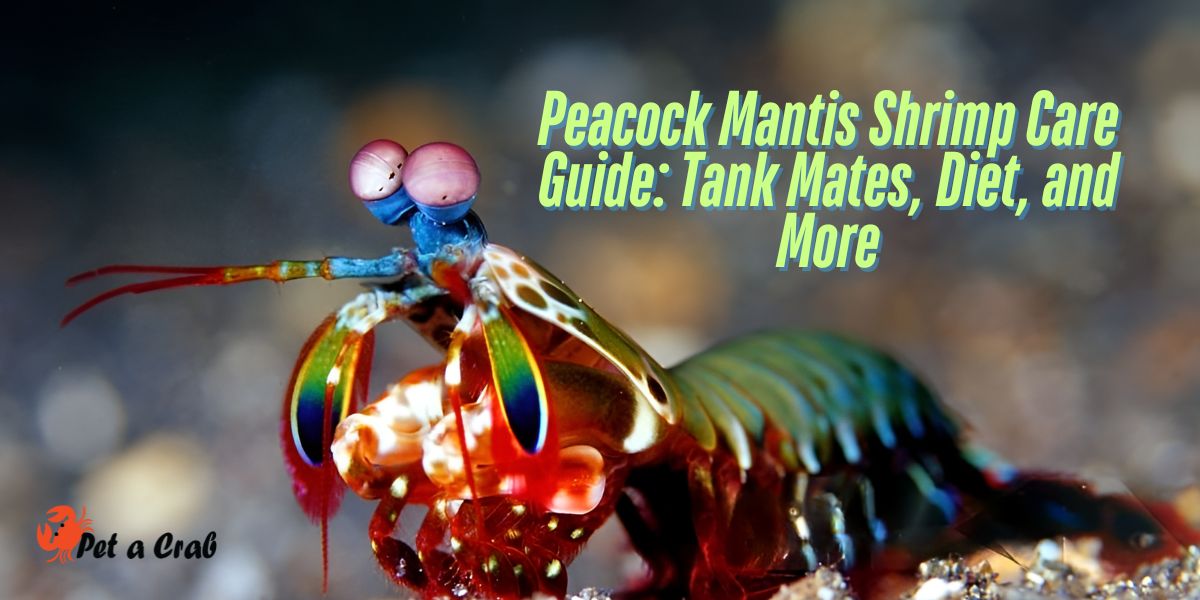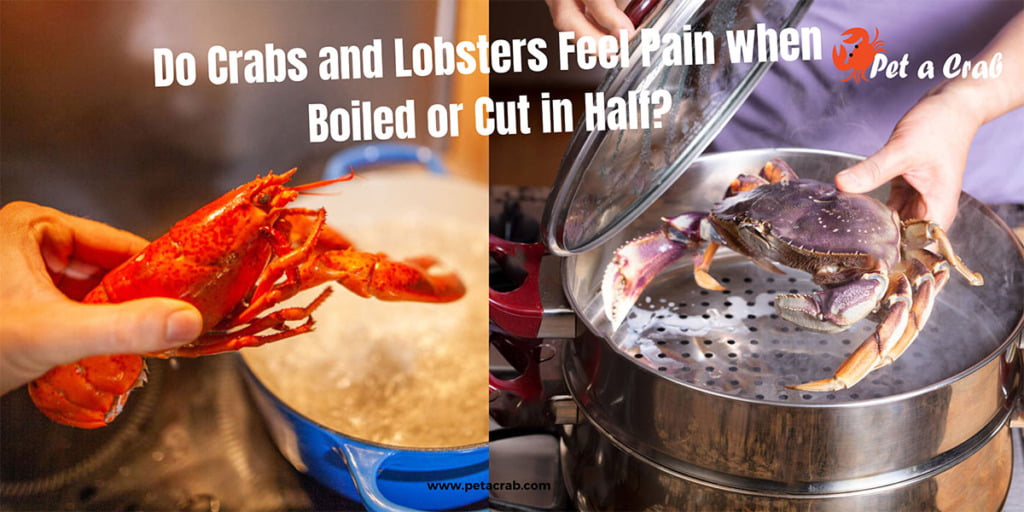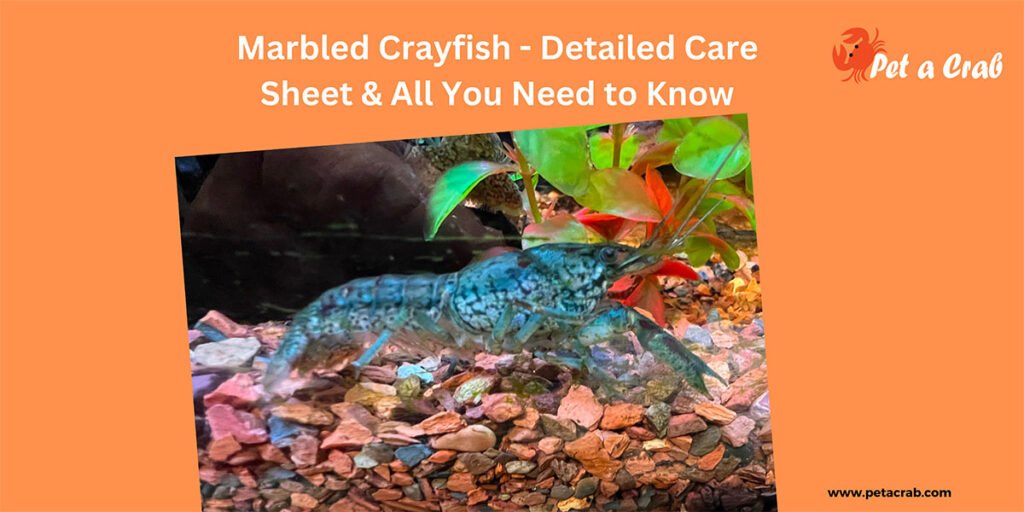Are you mesmerized by the peacock mantis shrimp and want one for a pet? These powerful and intelligent creatures require specific care that runs from a well-structured tank to protein-rich nutrition. But how about its tankmates? Can they coexist with other marine species?

In this mantis shrimp care guide, I will cover all you need to know about how to take care of mantis shrimp, its behavior, how to set up its habitat, and its feeding requirements. This guide will help both the amateur and the experienced aquarist give the best care to mantis shrimp.
Quick Facts About Mantis Shrimp
- Scientific Name: Stomatopoda
- Common Names: Peacock Mantis Shrimp, Thumb Splitters, Prawn Killers, Sea Locusts, Peacock Crab
- Size: 1 – 15 inches (2.5 – 40 cm)
- Color: Vibrant multi-color like Green, Blue, Red, and orange.
- Tank Size (Minimum): 10 gallons (40 litres)
- Temperature: 72-80°F (22-26°C)
- pH Level: 8.0 – 8.5
- KH Level: 8 – 16
- Nitrate Tolerance: Less than 20 ppm
- Diet: Carnivorous – feeds on fish, crustaceans, and mollusks
- Temperament: Very aggressive, territorial
- Reef Safe: No, may attack tankmates
- Sleeping Nature: Nocturnal
- Lifespan: 3 – 6 years
- Care Level: Easy
Are Mantis Shrimp Easy to Take Care Of?
Yes, as long as their needs are satisfied, mantis shrimp care is typically simple. Their care involves a well-maintained saltwater tank with proper hiding spots, stable water conditions, and a secure lid. They can do quite well in a reinforced acrylic tank with a wide variety of seafood and will make great pets for serious marine enthusiasts.
How to Take Care of a Mantis Shrimp?
If you’re wondering how to care for a mantis shrimp, you should be more concerned with their tank setup, diet, and habitat maintenance in general. Below is a peacock mantis shrimp care sheet to help you ensure their well-being.
Also Read More: Marbled Crayfish Detailed Care Sheet
- Tank Setup & Water Conditions
A proper tank setting will be highly relevant to the well-being and good health of your mantis shrimp, as these fascinating creatures do have certain specific habitat requirements.
Tank Size
The minimum for mantis shrimp should be within a range of 10 to 30 gallons. Larger species need more space to feel comfortable and grow. It would be very instrumental to account for their territorial nature and give them enough room without crowding when establishing their territory.
Water Parameters
Stability in saltwater conditions is essential for your mantis shrimp’s survival. Keep the temperature of the water between 72-80°F (22-26°C), and make sure it is very stable. pH should be maintained in a range from 8.0 to 8.5, mirroring natural ocean conditions, and the salinity should be between 1.023 and 1.025 SG.
Filtration & Flow
A strong filtration system is a must to keep the water clean and clear. The filter should handle the tank’s volume efficiently, maintaining water quality and minimizing waste buildup. Additionally, moderate water flow is necessary while mantis shrimp enjoy a little current; excessive flow can cause stress.
Substrate and Hiding Places
Fine sand substrate, which would be very similar to the natural sea bottoms where mantis shrimps burrow comfortably. Add live rock to serve for biological filtration and climbing surface as well. Put PVC pipes or other similar structures to provide a lot of hiding places.
Note: Regular water tests are crucial, as mantis shrimp are particularly sensitive to changes in water parameters. Keeping a high-quality water testing kit on hand will help ensure you’re maintaining ideal conditions.
- Feeding & Nutrition
Being carnivorous predators, mantis shrimps demand a great deal of variety and nutrition in their diet to thrive.
Feeding
Provide a varied diet consisting of shrimp, fish, squid, crabs, and mollusks. Pre-frozen foods like mysis shrimp, krill, and clam meat can be given for convenience.
Feeding Schedule
Avoid overfeeding mantis shrimp. Feed them every 2-3 days so that the water does not get contaminated from old, uneaten food. This will also give you a chance to see them in their natural hunting mode.
Calcium
They require calcium to support the constant growth of the exoskeleton. Supplement with crushed shells, cuttlebone, or enriching foods with calcium for healthy molts.
Aquarist’s Note: Calcium levels are very crucial, especially in molting periods. Poor calcium conditions may lead to incomplete molts that may cause health complications.
3. Tank Security & Compatibility
The mantis shrimp can be quite a demanding pet, especially when it comes to security and compatibility with other species.
Lid Security
Mantis shrimp are powerfully built and can break through weak tank enclosures. Use a reinforced acrylic lid to prevent escapes-these creatures have been known to shatter glass tanks with their powerful strikes.
Tankmates
Mantis shrimp are territorial and usually very aggressive towards the other inhabitants of the tank. They are best kept solitary or in species-only tanks.
Interaction
Mantis shrimp should never be handled as they have powerful claws that can even break aquarium glass. In the wild, mantis shrimp use their claws to crack open hard-shelled prey and deliver extremely rapid strikes. Even if your mantis shrimp is acting docile, remember that its claws are a real defense mechanism.
Aquarist’s Note: While mantis shrimp can be as interesting to watch, they should be treated hands-off. Aggressive and powerfully strong, mantis shrimps can be dangerous, both to other inhabitants of the aquarium and to their owners.
Mantis Shrimp Facts: Surprising Things About this Marine Predator
Fastest Punch in the Animal Kingdom
Mantis shrimp are famous for their incredibly fast and powerful punches. The smasher mantis shrimp can throw a punch at speeds of 50 mph, as fast as a .22 caliber bullet. The force behind their strike is equivalent to 1,500 newtons, enough to crack crab shells and even aquarium glass.
Cavitation Bubbles – A Second, Lethal Blow
Upon punching, the mantis shrimp creates a cavitation bubble, generating temperatures almost as hot as the surface of the sun for just a split second. This collapsing cavitation bubble then bursts in an acute shockwave that stuns or kills the prey-delivering a double impact attack.
The Marvelous Eyes of the Mantis Shrimp
Mantis shrimp have some of the most impressive eyes in the animal kingdom. Each eye is capable of operating independently and is trinocular-meaning they can perceive depth without needing to use both of them. Moreover, with 12 to 16 color photoreceptors, they see a range of colors far beyond the human.
Mantis Shrimp Habitat
Where do mantis shrimp live? Mantis shrimp live in tropical and subtropical waters, normally in coral reefs, between the rocks, and burrows in sand. They make tunnels at the bottom of the ocean, which they not only use for hunting but also to hide from predators. Some species can be found in deeper waters, while others can be found in shallow coastal zones.
Can Mantis Shrimp Survive in Captivity?
Yes, mantis shrimp can be kept in aquariums, but they require a well-maintained marine environment with proper salinity and hiding spaces. Due to their aggressive nature, they are often kept alone, as they can easily injure or kill tank mates.
Peacock Shrimp Size and Strength
The size of mantis shrimps depends on the species. Usually, they range from 1 to 15 inches in length, or 2.5 to 40 cm. The peacock mantis shrimp is perhaps one of the largest and better-known species.
Mantis Shrimp Behavior and Nature
Are mantis shrimp aggressive? Yes, mantis shrimp are highly territorial and aggressive. They will guard their burrows from intruders, including other mantis shrimp. Such mantis shrimp possess really strong claws or raptorial appendages that make them predators capable of breaking shells, glass, and human fingers.
Interaction with Other Marine Life
Most mantis shrimp are solitary. In an aquarium setting, mantis shrimp should not be housed with slow-moving or delicate fish because they may be mistaken for prey. With such speed and precision, mantis shrimp can capture and kill even the fastest-swimming marine animals.
Mantis Shrimp Diet
What do mantis shrimp eat in the wild? Mantis shrimp are opportunistic hunters and feed on anything from small fish to crustaceans, such as crabs and shrimp, snails and mollusks, worms, and other soft-bodied marine life.
Feeding Mantis Shrimp in Captivity
Mantis shrimp are kept in aquariums on fresh seafood diets such as shrimp, squid, and fish. A varied diet is needed to keep them healthy. Since their claws are adapted for breaking shells, they benefit from hard-shelled prey, which helps to keep their appendages strong.
Life Span and Growth of Mantis Shrimp
How long do mantis shrimp live? Mantis shrimp live for 3-6 years depending on the species type and environment. Larger species tend to live longer compared to smaller species.
Mantis Shrimp Molting Process
Mantis shrimps grow by a process called molting, where they shed their exoskeleton and build a new one. While this may be crucial for the development of the shrimp, it is their biggest weakness.
Final Thoughts
Proper zebra mantis shrimp care involves more than just feeding, it involves creating the ideal tank environment, monitoring water parameters, and understanding their behavior. By following this peacock shrimp facts guide, you’ll ensure your mantis shrimp’s well-being and a thriving aquarium. If you’re looking to expand your crustacean collection, don’t miss this “Red Swamp Crayfish Care” guide to get expert tips on another unique species. Visit Petacrab for more insights on caring for these incredible marine creatures.
Frequently Asked Questions
What is the mantis shrimp?
Mantis shrimp are sturdy marine crustaceans that attract attention with their striking appearance, featuring rapid, powerful claws utilized for hunting. They have very complex behaviors, along with wonderful vision, thus making them compelling aquarium inhabitants.
Can I keep a mantis shrimp as a pet?
Yes, mantis shrimp can be kept as pets in appropriately sized tanks. However, they require great attention to water quality, diet, and security to thrive in captivity.
Can I keep more than one mantis shrimp?
Generally, it is not advisable to keep multiple mantis shrimp in the same tank due to their highly territorial and aggressive nature, which can lead to fights and stress.
Can you keep mantis shrimp in a reef jar?
No, mantis shrimp need a larger tank that fits their size and territorial nature. Reef jars are too small and limiting; this can lead to stress and possible aggression towards other inhabitants of the tank.
Are mantis shrimp hard to keep?
Mantis shrimps are moderately easy to care for as long as proper attention is provided to the setup, feeding, and water parameters. Being territorial and needing adequate space makes them not suitable for beginners.



I am extremely impressed together with your writing talents and also with the layout to your weblog. Is this a paid subject or did you customize it yourself? Anyway keep up the excellent quality writing, it’s rare to look a great weblog like this one these days!